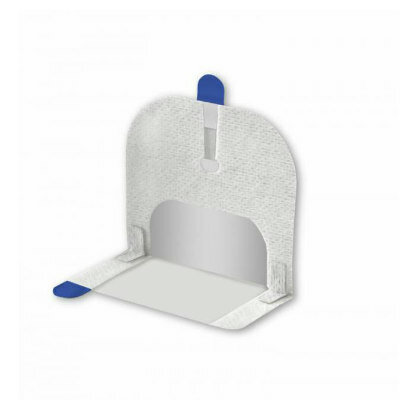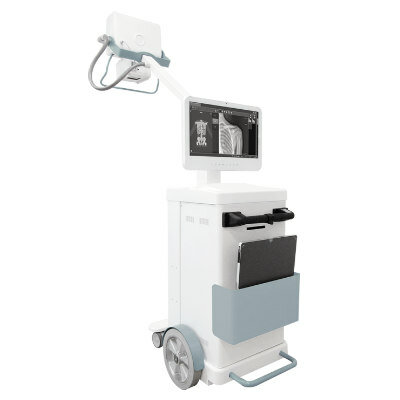Advanced Imaging Techniques Can Help Identify and Treat Nerve Damage in COVID-19 Patients, Finds Study
|
By MedImaging International staff writers Posted on 03 Dec 2020 |

Image: An MR image of a patient in their early 20s shows nerve injury of the left brachial plexus in the neck (Photo courtesy of Northwestern University)
A new study has shown how advanced imaging technology can pinpoint what may have caused nerve damage in COVID-19 patients and help determine the best course of treatment.
After recovering from COVID-19, some patients are left with chronic, debilitating pain, numbness or weakness in their hands, feet, arms and legs due to unexplained nerve damage. In the study, researchers from the Northwestern Medicine (Chicago, IL, USA) have demonstrated how advanced imaging techniques can help physicians identify and treat nerve damage in COVID-19 patients.
During their previous research, the researchers had found that COVID-19 patients can experience nerve damage after being flipped onto their stomachs (prone positioning) in the ICU as a life-saving measure to help them breathe. Their new study demonstrates how advanced imaging aids this cohort of patients as well as two additional patient cohorts with COVID-19-related nerve damage: secondary to an inflammatory immune response that attacked the nerves or from a hematoma (when blood collects outside of the blood vessels).
The imaging described in the study includes ultra-high-resolution ultrasound and MR neurography (MRI of peripheral nerves, which impact the arms and legs). They can help localize where a patient's problem is, show the severity of nerve damage, how many nerves are affected and if the nerve damage also has impacted the muscles. The advanced ultrasound technology is new, portable, less expensive and can sometimes be even better at detecting nerve damage than MRI. Ultrasound also can be performed on patients who are unable to tolerate MR imaging.
If imaging technology discovers nerve damage caused by stretch injury because of prone positioning, that patient may be referred to a physician who specializes in rehabilitation or peripheral nerve surgery. If imaging finds nerve damage due to an inflammatory response, the patient may be better served by seeing a neurologist. If imaging reveals nerve damage from a hematoma, blood thinner medications would have to be adjusted immediately and the patient may even have to see a surgeon. For COVID-19 patients and survivors with neuromuscular complications or "long-hauler" symptoms, imaging can help reveal the problem and guide further treatment.
"Let's say you have numbness in your fingers. That might actually be due to problems in your neck, elbow or wrist, and the best way to figure it out is with an MRI or ultrasound," said lead author Dr. Swati Deshmukh, assistant professor of radiology at Northwestern University Feinberg School of Medicine and a Northwestern Medicine radiologist. "We offer advanced imaging that shows even really, really small nerves, which helps us localize where the problem is, assess the severity and suggest what might be causing it."
"I want physicians and patients to be aware of the diagnostic options available due to recent innovations in technology, and inquire if advanced imaging might be right for them," added Dr. Swati Deshmukh.
Related Links:
Northwestern Medicine
After recovering from COVID-19, some patients are left with chronic, debilitating pain, numbness or weakness in their hands, feet, arms and legs due to unexplained nerve damage. In the study, researchers from the Northwestern Medicine (Chicago, IL, USA) have demonstrated how advanced imaging techniques can help physicians identify and treat nerve damage in COVID-19 patients.
During their previous research, the researchers had found that COVID-19 patients can experience nerve damage after being flipped onto their stomachs (prone positioning) in the ICU as a life-saving measure to help them breathe. Their new study demonstrates how advanced imaging aids this cohort of patients as well as two additional patient cohorts with COVID-19-related nerve damage: secondary to an inflammatory immune response that attacked the nerves or from a hematoma (when blood collects outside of the blood vessels).
The imaging described in the study includes ultra-high-resolution ultrasound and MR neurography (MRI of peripheral nerves, which impact the arms and legs). They can help localize where a patient's problem is, show the severity of nerve damage, how many nerves are affected and if the nerve damage also has impacted the muscles. The advanced ultrasound technology is new, portable, less expensive and can sometimes be even better at detecting nerve damage than MRI. Ultrasound also can be performed on patients who are unable to tolerate MR imaging.
If imaging technology discovers nerve damage caused by stretch injury because of prone positioning, that patient may be referred to a physician who specializes in rehabilitation or peripheral nerve surgery. If imaging finds nerve damage due to an inflammatory response, the patient may be better served by seeing a neurologist. If imaging reveals nerve damage from a hematoma, blood thinner medications would have to be adjusted immediately and the patient may even have to see a surgeon. For COVID-19 patients and survivors with neuromuscular complications or "long-hauler" symptoms, imaging can help reveal the problem and guide further treatment.
"Let's say you have numbness in your fingers. That might actually be due to problems in your neck, elbow or wrist, and the best way to figure it out is with an MRI or ultrasound," said lead author Dr. Swati Deshmukh, assistant professor of radiology at Northwestern University Feinberg School of Medicine and a Northwestern Medicine radiologist. "We offer advanced imaging that shows even really, really small nerves, which helps us localize where the problem is, assess the severity and suggest what might be causing it."
"I want physicians and patients to be aware of the diagnostic options available due to recent innovations in technology, and inquire if advanced imaging might be right for them," added Dr. Swati Deshmukh.
Related Links:
Northwestern Medicine
Latest MRI News
- PET/MRI Improves Diagnostic Accuracy for Prostate Cancer Patients
- Next Generation MR-Guided Focused Ultrasound Ushers In Future of Incisionless Neurosurgery
- Two-Part MRI Scan Detects Prostate Cancer More Quickly without Compromising Diagnostic Quality
- World’s Most Powerful MRI Machine Images Living Brain with Unrivaled Clarity
- New Whole-Body Imaging Technology Makes It Possible to View Inflammation on MRI Scan
- Combining Prostate MRI with Blood Test Can Avoid Unnecessary Prostate Biopsies
- New Treatment Combines MRI and Ultrasound to Control Prostate Cancer without Serious Side Effects
- MRI Improves Diagnosis and Treatment of Prostate Cancer
- Combined PET-MRI Scan Improves Treatment for Early Breast Cancer Patients
- 4D MRI Could Improve Clinical Assessment of Heart Blood Flow Abnormalities
- MRI-Guided Focused Ultrasound Therapy Shows Promise in Treating Prostate Cancer
- AI-Based MRI Tool Outperforms Current Brain Tumor Diagnosis Methods
- DW-MRI Lights up Small Ovarian Lesions like Light Bulbs
- Abbreviated Breast MRI Effective for High-Risk Screening without Compromising Diagnostic Accuracy
- New MRI Method Detects Alzheimer’s Earlier in People without Clinical Signs
- MRI Monitoring Reduces Mortality in Women at High Risk of BRCA1 Breast Cancer
Channels
Radiography
view channel
Novel Breast Imaging System Proves As Effective As Mammography
Breast cancer remains the most frequently diagnosed cancer among women. It is projected that one in eight women will be diagnosed with breast cancer during her lifetime, and one in 42 women who turn 50... Read more
AI Assistance Improves Breast-Cancer Screening by Reducing False Positives
Radiologists typically detect one case of cancer for every 200 mammograms reviewed. However, these evaluations often result in false positives, leading to unnecessary patient recalls for additional testing,... Read moreMRI
view channel
PET/MRI Improves Diagnostic Accuracy for Prostate Cancer Patients
The Prostate Imaging Reporting and Data System (PI-RADS) is a five-point scale to assess potential prostate cancer in MR images. PI-RADS category 3 which offers an unclear suggestion of clinically significant... Read more
Next Generation MR-Guided Focused Ultrasound Ushers In Future of Incisionless Neurosurgery
Essential tremor, often called familial, idiopathic, or benign tremor, leads to uncontrollable shaking that significantly affects a person’s life. When traditional medications do not alleviate symptoms,... Read more
Two-Part MRI Scan Detects Prostate Cancer More Quickly without Compromising Diagnostic Quality
Prostate cancer ranks as the most prevalent cancer among men. Over the last decade, the introduction of MRI scans has significantly transformed the diagnosis process, marking the most substantial advancement... Read moreUltrasound
view channel
Deep Learning Advances Super-Resolution Ultrasound Imaging
Ultrasound localization microscopy (ULM) is an advanced imaging technique that offers high-resolution visualization of microvascular structures. It employs microbubbles, FDA-approved contrast agents, injected... Read more
Novel Ultrasound-Launched Targeted Nanoparticle Eliminates Biofilm and Bacterial Infection
Biofilms, formed by bacteria aggregating into dense communities for protection against harsh environmental conditions, are a significant contributor to various infectious diseases. Biofilms frequently... Read moreNuclear Medicine
view channel
New SPECT/CT Technique Could Change Imaging Practices and Increase Patient Access
The development of lead-212 (212Pb)-PSMA–based targeted alpha therapy (TAT) is garnering significant interest in treating patients with metastatic castration-resistant prostate cancer. The imaging of 212Pb,... Read moreNew Radiotheranostic System Detects and Treats Ovarian Cancer Noninvasively
Ovarian cancer is the most lethal gynecological cancer, with less than a 30% five-year survival rate for those diagnosed in late stages. Despite surgery and platinum-based chemotherapy being the standard... Read more
AI System Automatically and Reliably Detects Cardiac Amyloidosis Using Scintigraphy Imaging
Cardiac amyloidosis, a condition characterized by the buildup of abnormal protein deposits (amyloids) in the heart muscle, severely affects heart function and can lead to heart failure or death without... Read moreGeneral/Advanced Imaging
view channel
New AI Method Captures Uncertainty in Medical Images
In the field of biomedicine, segmentation is the process of annotating pixels from an important structure in medical images, such as organs or cells. Artificial Intelligence (AI) models are utilized to... Read more.jpg)
CT Coronary Angiography Reduces Need for Invasive Tests to Diagnose Coronary Artery Disease
Coronary artery disease (CAD), one of the leading causes of death worldwide, involves the narrowing of coronary arteries due to atherosclerosis, resulting in insufficient blood flow to the heart muscle.... Read more
Novel Blood Test Could Reduce Need for PET Imaging of Patients with Alzheimer’s
Alzheimer's disease (AD), a condition marked by cognitive decline and the presence of beta-amyloid (Aβ) plaques and neurofibrillary tangles in the brain, poses diagnostic challenges. Amyloid positron emission... Read more.jpg)
CT-Based Deep Learning Algorithm Accurately Differentiates Benign From Malignant Vertebral Fractures
The rise in the aging population is expected to result in a corresponding increase in the prevalence of vertebral fractures which can cause back pain or neurologic compromise, leading to impaired function... Read moreImaging IT
view channel
New Google Cloud Medical Imaging Suite Makes Imaging Healthcare Data More Accessible
Medical imaging is a critical tool used to diagnose patients, and there are billions of medical images scanned globally each year. Imaging data accounts for about 90% of all healthcare data1 and, until... Read more
Global AI in Medical Diagnostics Market to Be Driven by Demand for Image Recognition in Radiology
The global artificial intelligence (AI) in medical diagnostics market is expanding with early disease detection being one of its key applications and image recognition becoming a compelling consumer proposition... Read moreIndustry News
view channel
Bayer and Google Partner on New AI Product for Radiologists
Medical imaging data comprises around 90% of all healthcare data, and it is a highly complex and rich clinical data modality and serves as a vital tool for diagnosing patients. Each year, billions of medical... Read more




















